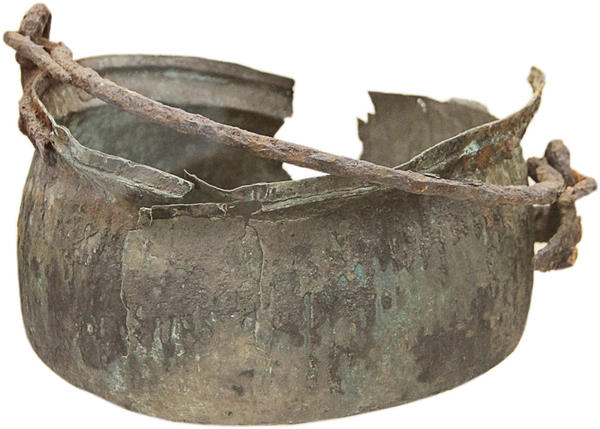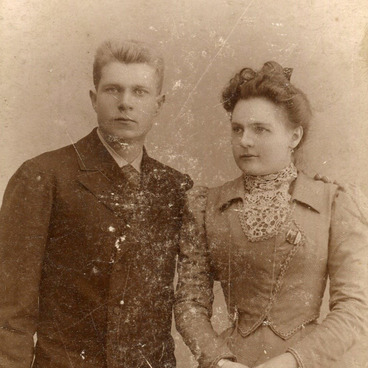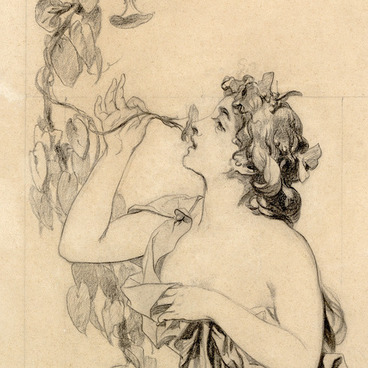The kettle was found in the 161st burial of the Starodevichensky burial ground near the village of Starodevichye in the Yelnikovsky district of the Republic of Mordovia in 1989 by I.M.Petersburgsky. Transferred to the museum funds by A.A.Begovatkin in 2003.
The kettle is made of bronze sheet without a connecting seam. A movable bow, rectangular in cross-section, is inserted into iron loops, which are attached to the walls with rivets. The body of the jar is enlarged in the lower part, the straight corolla is bent along the edge. Lengthwise notches decorate the outside walls. The kettle was discovered in a warrior’s burial.
There are no more than 7% of such burials of all of that kind found within the territory of Mordovia. The armament complex of a professional warrior included arrowheads, a spearhead, an ax, a saber, a shield, a metal kettle, details of horse equipment.
The find is one of the artifacts discovered in the Starodevichensky burial ground. The archaeological site of Mordvins-Moksha dates back to the 11th – 14th centuries and is located in the vicinity of the Starodevichye village. Excavations within the territory were carried out from 1987 to 1993 under the direction of I.M.Petersburgsky.
The kettle is made of bronze sheet without a connecting seam. A movable bow, rectangular in cross-section, is inserted into iron loops, which are attached to the walls with rivets. The body of the jar is enlarged in the lower part, the straight corolla is bent along the edge. Lengthwise notches decorate the outside walls. The kettle was discovered in a warrior’s burial.
There are no more than 7% of such burials of all of that kind found within the territory of Mordovia. The armament complex of a professional warrior included arrowheads, a spearhead, an ax, a saber, a shield, a metal kettle, details of horse equipment.
The find is one of the artifacts discovered in the Starodevichensky burial ground. The archaeological site of Mordvins-Moksha dates back to the 11th – 14th centuries and is located in the vicinity of the Starodevichye village. Excavations within the territory were carried out from 1987 to 1993 under the direction of I.M.Petersburgsky.
The total area of the burial territory was 1.2 hectares, the height of the burial ground reached 12 meters. It used to be an artificial mound ruined in the course of time.
A total of 230 graves were discovered. Most of them were rectangular in shape, some were rounded and narrowed at one end. The size depended on the age and height of the buried. Children were buried in graves not exceeding 140 cm in length; pits for adult men reached three metres.
Archaeologists discovered traces of coal and ash at the bottom. I.M. Petersburgsky suggested that those were remains of memorial bonfires that were arranged outside the burial ground. The dead were not burnt, but laid on bast bedding and covered with linen, sometimes coffins were made of wood. There could be several people in one grave pit.
In solitary graves, the deceased were laid face up, mainly with their head to the south. In women, hands were folded on the chest, in men, one arm was extended along the torso. Parts of clothing, household items, weapons and jewelry were found in the graves.
In female burial places, jewelry items were found: small forehead rims, syulgamas, jingling pendants, rings and pulokeri – braid decorations. The age of the burial ground was determined according to the jewelry forms.
Men were buried with weapons – among the found artifacts there are axes, spears and arrowheads. Knives, flint, wicks tubes and awls were located at the belt level. Glass beads were found in four men’s graves, which indicates the existence of a ‘sacrifice’ rite common among Finno-Ugric peoples.
Findings from the Starodevichensky burial ground give an idea of the Mordovian-Moksha everyday life. The main occupation was agriculture – wheat, rye, millet, flax and hemp were grown in the fields. The development of livestock breeding is evidenced by the bones of cows, sheep and pigs found in burials. Hunting, fishing and beekeeping played no less important role in the life of people.
The finds indicate the high development of weaving and spinning in this area. The threads were painted in different colors, the most common were red, blue, black and brown. Yarn from flax and hemp was bleached in the sun.
Iron weapons and tools may be seen among the items found. The handles were made of wood. Oriental coins, rich belt sets, as well as several bronze kettles, which were common among Turkic-speaking tribes, indicate that Mordovians had trade relations with other peoples.
A total of 230 graves were discovered. Most of them were rectangular in shape, some were rounded and narrowed at one end. The size depended on the age and height of the buried. Children were buried in graves not exceeding 140 cm in length; pits for adult men reached three metres.
Archaeologists discovered traces of coal and ash at the bottom. I.M. Petersburgsky suggested that those were remains of memorial bonfires that were arranged outside the burial ground. The dead were not burnt, but laid on bast bedding and covered with linen, sometimes coffins were made of wood. There could be several people in one grave pit.
In solitary graves, the deceased were laid face up, mainly with their head to the south. In women, hands were folded on the chest, in men, one arm was extended along the torso. Parts of clothing, household items, weapons and jewelry were found in the graves.
In female burial places, jewelry items were found: small forehead rims, syulgamas, jingling pendants, rings and pulokeri – braid decorations. The age of the burial ground was determined according to the jewelry forms.
Men were buried with weapons – among the found artifacts there are axes, spears and arrowheads. Knives, flint, wicks tubes and awls were located at the belt level. Glass beads were found in four men’s graves, which indicates the existence of a ‘sacrifice’ rite common among Finno-Ugric peoples.
Findings from the Starodevichensky burial ground give an idea of the Mordovian-Moksha everyday life. The main occupation was agriculture – wheat, rye, millet, flax and hemp were grown in the fields. The development of livestock breeding is evidenced by the bones of cows, sheep and pigs found in burials. Hunting, fishing and beekeeping played no less important role in the life of people.
The finds indicate the high development of weaving and spinning in this area. The threads were painted in different colors, the most common were red, blue, black and brown. Yarn from flax and hemp was bleached in the sun.
Iron weapons and tools may be seen among the items found. The handles were made of wood. Oriental coins, rich belt sets, as well as several bronze kettles, which were common among Turkic-speaking tribes, indicate that Mordovians had trade relations with other peoples.



